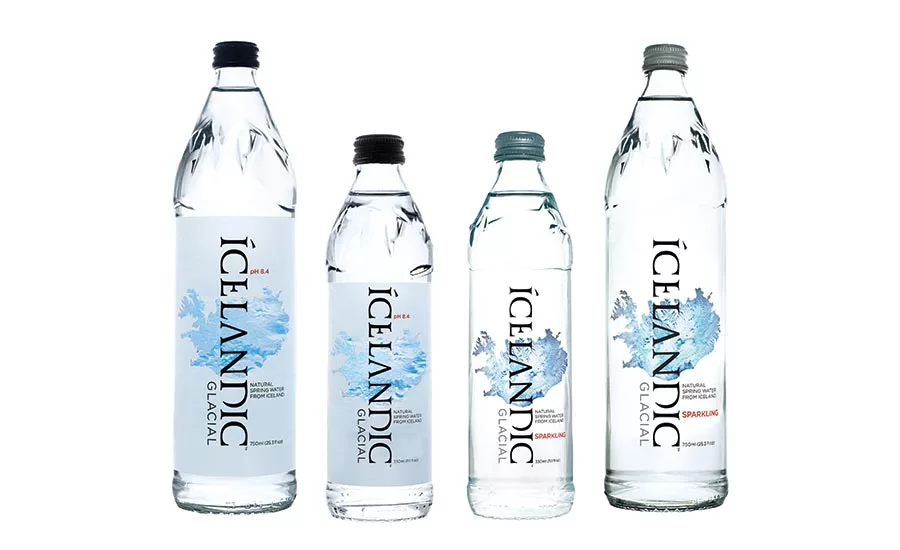Dietary Guidelines align with consumer trends
Processes for 2020 Dietary Guidelines to begin later this year

Bottled water sales were up 19 percent from 2012 to 2015. The 2015-2020 Dietary Guidelines suggest water as one of the primary beverages to consume. (Image courtesy of Icelandic Glacial Inc.)
In January 2016, the U.S. Department of Agriculture (USDA) and Health and Human Services (HHS) released the 2015-2020 Dietary Guidelines. The eighth edition of this report highlighted the importance of following a healthy eating plan that includes a variety of nutrient-dense foods as well as limiting calories from components such as added sugars, saturated fats and reducing sodium intake.
The notion of balance has become important as consumers and food and beverage manufacturers support healthy eating patterns for the masses.
“Both the USDA and HHS said clearly [that] when it comes to achieving a healthy weight, [it is] overall diet — not one ingredient or product,” says Susan Neely, president and chief executive officer of the American Beverage Association (ABA), Washington, D.C.
Neely adds that the guidelines remain a key component not only in consumers purchase decisions, but also in nutrition policy.
“We thought the Dietary Guidelines reaffirmed some things that were important,” she says. “The guidelines shape nutrition policy certainly at the federal level, but they can also influence state and local nutrition policy. We thought the guidelines were very sound in that regard.”
When it comes to beverages, the guidelines note the importance of considering calories and nutrients.
“Beverages that are calorie-free — especially water — or that contribute beneficial nutrients such as fat-free and low-fat milk and 100 percent juice, should be the primary beverages consumed,” the report states.
Sugar-sweetened beverages are options that consumers can include in their eating plan, but amounts should be within the overall calorie limits and limits of calories from added sugars, the report adds. In the Added Sugars section, the USDA and HHS suggest only 10 percent of daily calories come from added sugars.
Neely says this suggestion aligns with consumer-thinking when it comes to balance. “USDA guidelines say that when water just won’t do, you should have a treat, have a soft drink in moderation,” she says. “That’s exactly what I think about as a mom and that’s what I say to my kids. That’s spot on.”
The guidelines also indicate that coffee, tea and flavored waters can be selected; however, calories from cream and sugar need to be taken into account if added.
Experts note that the guidelines are a reflection of the modern U.S. consumer and what is important to them. “The USDA Dietary Guidelines have helped reinforce a trend that consumers were already moving toward; Americans are being more proactive with their health,” says Andrew Mandzy, director of strategic insights for New York-based Nielsen. “We can see that more broadly in the fact that people are exercising more, reading nutritional labels and making decisions off of them, looking for health information online, and in general being active participants in their health management.”
An example of this health management is the bottled water market. “From 2012-2015, the market for bottled water grew $1.6 billion in dollar sales, or an increase of 19 percent,” Mandzy explains. “In the most recent year, bottled water sales grew 5 percent when compared to the previous year. Sparkling water has also increased, up 21 percent from last year and up 84 percent from 2012.
“The current market for sparkling water adds an additional $1.7 billion to water sales,” he continues. “As consumers look for products with simpler ingredients, even in the competitive beverage category where healthier options are appearing constantly, bottled water has benefited.”
However, the other primary beverages that should be consumed based on the guidelines were not as successful. “Traditional dairy milk has seen an influx in competition in recent years from milk alternatives and varieties,” Mandzy says. “Milk, a category with $15.9 billion in annual sales, has declined 6 percent compared to last year. Regular white milk, representing 67 percent of category sales, saw an 11 percent dollar loss.
“Organic white milk grew 1 percent during this time period, representing 9 percent of all milk sales,” he continues. “Milk substitutes like almond, soy and coconut milk grew 15 percent when compared to last year. Organic milk has driven much of the growth within the declining sales of the milk case, honing in on the health assurance that many consumers are looking for with young children in mind.”
Shelf-stable juice fared better than milk; however, not the growth posted by bottled water. “The shelf-stable juice category has seen relatively flat growth from 2012-2016, wavering no more than 1 percent,” Mandzy says. “Varieties with 100 percent juice claims were also flat in the last year, through a number of growths and declines over the last five years.”
Although the current edition of the Dietary Guidelines only is a year old, preparations already are beginning for the 2020-2025, ninth edition. The ABA’s Neely notes that the key for the next guidelines will be sound scientific support. “The process for formulating the 2020 guidelines will begin later this year,” she says. “We will reinforce with the Trump Administration and Congress the importance of sound science in development of the nation’s nutrition policy.”
Looking for a reprint of this article?
From high-res PDFs to custom plaques, order your copy today!




